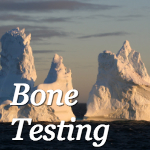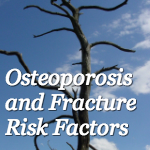 A One-Woman Dexa Scan Report: 2004
A One-Woman Dexa Scan Report: 2004
Bone scans let us know we have bone density problems before we suffer irreparable damage, but dexa scan measurement may not be as accurate as we expect. If we know more about the accuracy of the testing, we know how to interpret the results.
Below, you’ll find my dexa scan results. I had two tests taken two weeks apart with the same equipment and operator in 2003. One year later, I was tested on different equipment. I had two tests on this equipment, two weeks apart with the same operator. Tests taken two weeks apart gave readings differing as much as 5.7%. With this in mind, we need to see long-term trends with quite a few readings before getting excited about small percentage changes in bone density.
Norland dexa scan equipment
Date measured:
7/03/03 L2-L4: .848 g/cm2
7/15/03 L2-4: .802 g/cm2, T score –1.85
–5.7% difference in tests taken 2 weeks apart
7/03/03 L femoral neck: .641 g/cm
7/15/03 L femoral neck: .631 g/cm2, T score –3.04
-1.5% difference in tests 2 weeks apart
Lunar dexa scan equipment
Date measured:
7/13/04 L2-4: .914 g/cm2, T score –2.4
7/26/04 L2-4: .925 g/cm2, T score –2.3
+1.2% difference in tests 2 weeks apart
7/13/04 Femoral neck average: .772 g/cm2 or T score –1.8
7/26/04 Femoral neck average: .735 g/cm2, T score –2.0
-4.8% difference in tests taken 2 weeks apart
My 2003 and 2004 measurements were taken on different machines.
I went to the Osteoporosis and Bone Physiology website for the standard formulas used for comparing results from different dexa equipment. I plugged in my test results from 2003 and 2004 and the comparison between the Norland data and Lunar data showed a –16.5% in the spine and +12% in the L hip in one year — impossible results since bone density increases only 1-2% a year in post menopausal women.
My Conclusions
The official medical formulas for comparing results from different machines are unreliable—at least in my case.
Bone density testing on the same machine and operator, same time of day, 2 weeks apart, gave a range from -1.5 to -5.7% difference one year and +1.2 to -4.8% the next. An article in the Journal of Bone and Mineral Research reported 4% variation in bone scans taken within 7 days, so these findings might be common if women were to do repeat testing. (Neither dexa scan operator had ever done a repeat test, so they were both surprised by the discrepancy in the results.) For individual results as opposed to a group study where individual variations are averaged, I’ll look for long-term trends of 6-7% change over a number of years before celebrating or lamenting dexa scan results. (Y. Lu, T. Fuerst, S. Hui and H.K. Genant, Standardization of Bone Mineral Density at Femoral Neck, Trochanter and Ward’s Triangle, Osteoporos Int (2001) 12:438-444. and Hui, SL, et al. Universal Standardization of Bone Density Measurements: A Method with Optimal Properties for Calibration Among Several Instruments. J Bone Mineral Research 1997; 12:1463-70.)
Exercise that strengthens muscles diminishes fracture risk even when bone scan measurement is unchanged. A dramatic example of this comes from the journal Bone. In a 2002 study, spinal fracture was lowered by two-thirds after a two-year back-strengthening program even though bone scan measurements didn’t improve in exercisers compared with controls. Actual fractures were assessed 8 years after the exercise study ended, so the improvement in fracture risk lasted.
Related Posts:





November 4, 2013 at 4:04 pm
Dianne Marshfield, Ma.
Hi, I have been questioning the accuracy also. I had disk surgery years ago to lower spine and have been great since. I read that in patients who have had previous surgery the machine may encounter interference which could lead to less accurate results. I will have to see what my Dr. says about that. I think they check 3 areas and take the worst of the 3 to give the diagnosis, so we will see. Had to stop alondrondate medication because I needed dental work. Was so scared that my jaw would rought off as this is a side effect of the medication in some. In the meantime I am taking Vitamin K2, and D but cut down calcium because of the latest news about that being bad for you. Also I am taking soy isoflavones with Genstein. Was taking 2 tums per day plus vitamin supplement with calcium and I believe that was the cause for diverticulosis. I recovered from both and an doing great but I am not looking forward to going back to see Dr. in a couple of months. I cannot imagine what she’ll want me to take then?
It is great there are people like you who follow up on things and share with others.
Thanks
It seems your tests were so way off that it makes you wonder, especially if you exercise.
November 4, 2013 at 6:46 pm
Elaine Mansfield
Hi Dianne,
I don’t know how this sort of surgery would change a scan, but someone should be able to give you accurate information. Make sure you’re using Vitamin D3 (not D2) and eat lots of fruits and vegetables because the minerals and alkalizing effect are extremely helpful for bones. I suggest you visit BetterBones.com where Dr. Susan Brown has excellent nutritional information and deep knowledge about bone health. I wouldn’t worry about every detail she explores, but you’ll get good information there and be able to choose what’s best for you. I like her newsletter.
I did two terrible things for my bones as a young woman–smoked cigarettes as a teenager and repeatedly lost and gained weight. I had my dexascans well after menopause and after a few years of strength training and weight-bearing aerobics–so nothing in my habits could explain the big changes from test to test. In recent years (I’m in my late 60s), my scans have stayed about the same as the scans from 15 years ago–on the edge between osteoporosis and osteopenia. I have dexascans rarely now because of that stability and because of my good health habits. I’m very active and take hard falls occasionally in the course of outdoor activity with my dog or slipping in winter snow. I’ve never broken a bone, so I assume they’re plenty durable. The good exercise brought strong architectural strength even though it doesn’t do much to improve density as tested by dexascan.
I hope you have a doctor who understands all the intricacies of bone health. I’ve been lucky in that way.
Thanks for letting me know the article helped you. Makes me happy as a writer. Since my husband’s death, I write about bereavement issues and living on my own as you may have noticed at my website. Maybe you’ll find some of my recent writing of interest, too.
Best to you,
Elaine
August 9, 2013 at 10:24 am
Jean
Hello, good morning. I so appreciate reading what you wrote here. I also noted on another site the great difference between a T and Z DEXA scanning. I’ve just had the “T” test for the first time (at 61) and am shocked at the results, that I have osteoporosis in a number of areas. My diet is very high in calcium which I have also read may not be so good. Funny, isn’t it.
Thank you for this site and it’s information.
August 9, 2013 at 1:02 pm
Elaine Mansfield
Hi Jean, thanks for your note. I suggest you read other articles about bone health at my site, if you haven’t alrady, and also go to Better Bones (http://www.betterbones.com/default.aspx) for excellent bone health information with lots of encouraging details. Susan Brown of Better Bones is great with the nutritional aspects of bone health. I don’t find her exercise information quite as good, but she has many ideas and my exercise information can take you where you need to go. Don’t get discouraged since many women in the world have low bone density but also low fracture incidence. It’s not as simple as those bone scans.
Best to you and your bones, Elaine